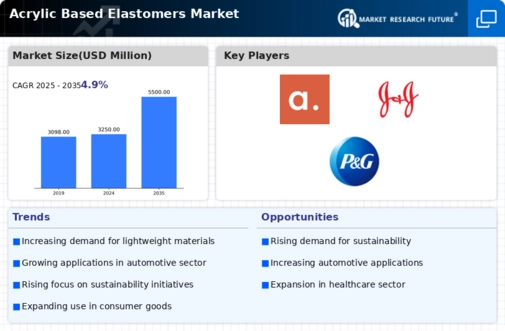Acrylic Based Elastomers Size
Acrylic Based Elastomers Market Growth Projections and Opportunities
The dynamics of the Acrylic-Based Elastomers market are influenced by a multitude of variables. The main factor driving this market forward is the increasing demand for products like automobiles, building and construction, and industrial output. They are widely used in many fields because they have high elasticity and resistance to many factors such as weather, which makes these compounds exceptional. In fact, the process of manufacturing various things depends on their availability or otherwise due to their sensitivity towards expansions within different sectors.
The condition of the global economy determines a lot in Acrylic-Based Elastomers market. Macroeconomic indicators including the automobile industry’s state as well as building/construction sectors plus industrial manufacturing dictate whether consumers will buy more elastomeric goods or not. This is because there is a direct relationship between growth rates experienced worldwide and demand for acrylic based elastomers that usually find extensive use during housing projects; auto production processes; manufacturing; consumer goods fabrication apart from others. On the other hand, low economic activity may reduce investment in these areas thereby affecting this industry negatively.
Most often than not, market changes occur due to new modifications made on elastomeric compositions. Through improvements made on polymer chemistry and compounding techniques besides performance characteristics, it may be possible to lengthen service life periods for elastomer-containing materials produced using acrylics, increase flexibility or even reduce cost prices associated with them among several other benefits. Thus, to be at the top in the Acrylic-Based Elastomers market and gain a competitive advantage over rivals, firms should invest into R&D as well as focus on meeting changing demands of the industry.
The Acrylic-Based Elastomers market is highly dependent on supply chain characteristics, such as the price and availability of raw materials. The main elements that make up this group of elastomers are acrylic monomers and other compounding agents. Raw material prices drive certain manufacturing costs that in turn determine dynamics taking place within markets for them. For instance, efficient and reliable delivery systems have to be maintained in order to ensure stability in the market coupled with consistent supplies of acrylic-based elastomers to consumers.
Moreover, Geopolitical variables including global trade policies also play an important role in influencing the Acrylic-Based Elastomers market forces. This leads to shifts within demand and supply sides of global chemical business due to various issues including tariffs, trade agreements as well as geopolitical conflicts. As a result, players involved must understand how they can deal with these kinds of external pressures for them to effectively manage international commercial relationships.
Major participants’ market shares change competitive dynamics in acrylic-based elastomer industry through strategic efforts. Companies therefore seek ways of strengthening their positions through innovation in products; widening their portfolios; or entering into strategic alliances. Consequently, many organizations prefer merging or acquiring others so as they can remain ahead in terms of product offering when compared with rivals thus gaining more mileage against competitors who opt out via consolidation processes among themselves.







Leave a Comment